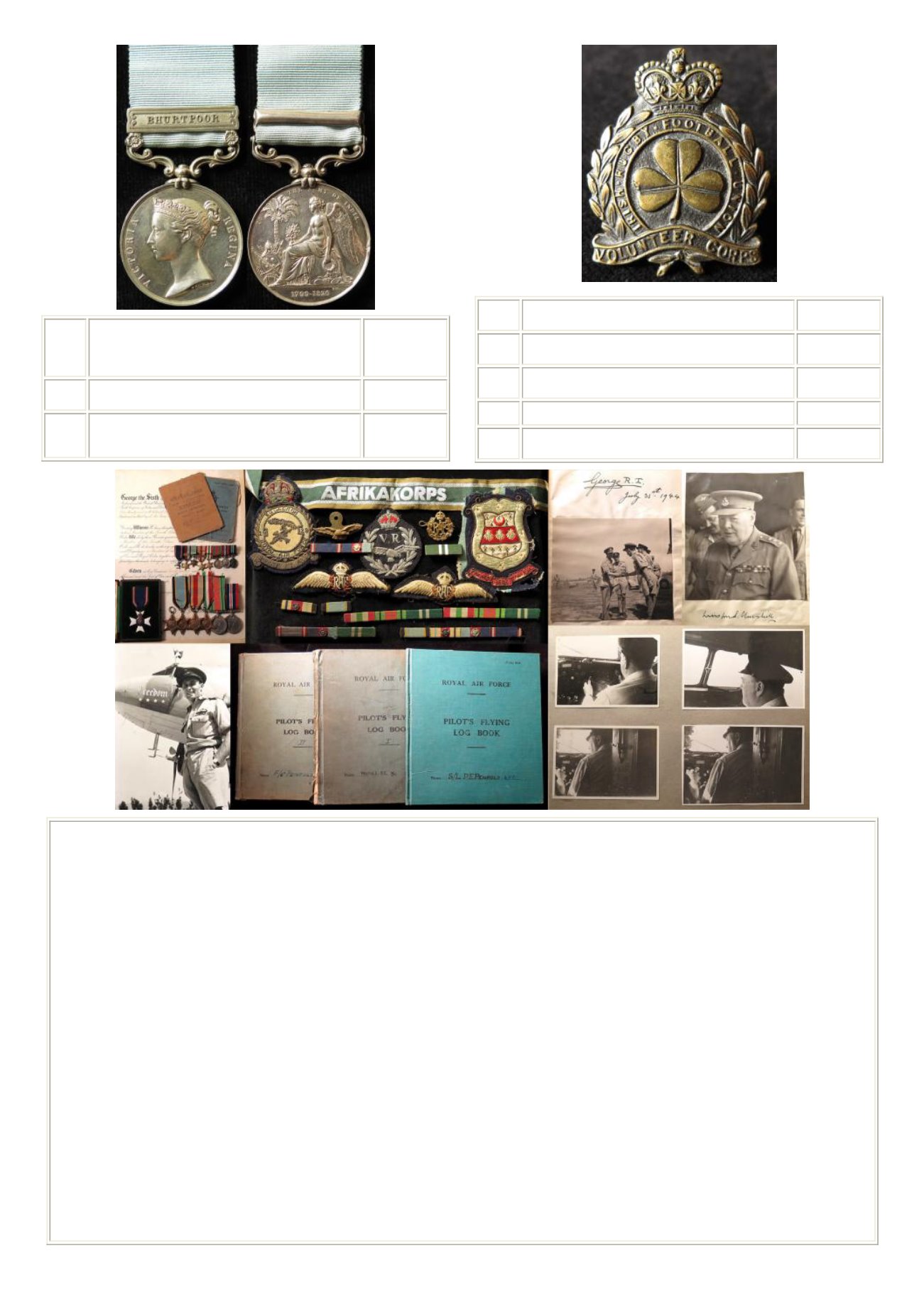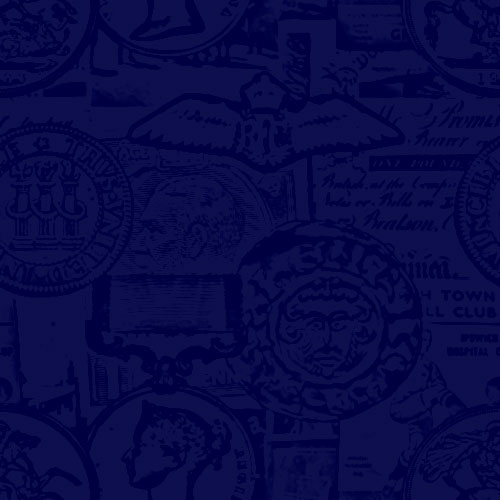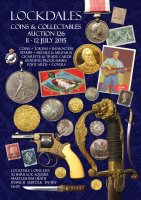

15
310
Army of India Medal 1851 with Bhurtpoor clasp
correctly impressed to Corpl T. Henry, 59th Foot.
Thomas Henry is confirmed to roll (184 to Regt) Small
edge bump nEF
£1000 - £1100
311
ARP Wardens helmet with ARP 1940 dated axe and gas
mask bag
£65 - £70
312
Australian Service Medal GVI named VX27209 F A
Lindsay. Killed In Action 6/2/1943 New Guinea with
the 2/7th AIF. Buried Lae War Cemetery. EF (1)
£25 - £30
313
Badge - Irish Rugby Football Union Volunteer Corps.
Rare
£200 - £250
314
Badges South Wales Borderers 4x cap badges and a
collar badge inc. all brass
£25 - £30
315
Badges, a selection of East Surrey Regt cap badges all
different in some respect, mostly GVF.
£30 - £35
316
Badges, selection of cap badges (qty)
£40 - £45
317
Baltic Medal 1856 unnamed as issued (disc only), plus a
few cap badges a/f
£30 - £35
318
Battle of Britain lot to 77684 P/O Pilot Paul Eric Penfold 29 Squadron. Medals - Member of the Victorian Order (MVO) cased, Numbered 1457, with original framed
Certificate 13/7/1944. 1939-45 Star (entitled to BOB clasp, but this is MISSING), Air Crew Europe Star, Africa Star (entitled to the North Africa clasp, this MISSING), Italy
Star, Defence & War Medals, also entitled to Air Efficiency Award GVI (this MISSING). Plus full original Miniature Medal group. Group comes with a mass of original
ephemera including Penfolds RAF Pilots Log Books x3 starting 26th Sept 1937 to 27th Sept 1945. His own personal Autograph Album with photos and the persons signature
inc Field Marshall Maitland Wilson, King GVI, Winston Churchill, Montgomery, etc etc. various cloth badges, silver hallmarked hip flask, silver snuff box, various maps, RAF
Note Books, a large photo album, and a bundle of A/M Press photos, and other loose photos (qty). His RAF Service & Release Book, Middle East ID Book, etc etc. (His
Logbooks show he spent some time stationed at Martlesham Heath) Below is Penfolds entry in the Battle of Britain Book: Penfold was born in November 1915 at Barnham,
Sussex and was educated at Woodbridge Public School, Suffolk. In April 1937 he joined the RAFVR at Brighton and carried out his flying training at Shoreham Airport, in
Tiger Moths, Audaxes and Battles. Penfold was awarded his wings in 1938 and when he was called up on 1st September 1939 he had 250 flying hours in his logbook, a large
number for a VR pilot. In the latter part of the year Penfold was posted to 3 FTS, South Cerney for a twin-engine conversion course and on 1 February 1940 he was
commissioned, arrived at 12 Group Pool in March, converted to Blenheims and was then posted to 29 Squadron at Debden on April 6. Penfold served with the squadron
during the Battle of Britain, on night fighting duties at various fighter stations. On 3 September 1940 he was posted to 6 OTU, Sutton Bridge, as an instructor, converting
Polish Pilots to Hurricanes. Penfold was later posted to 73 OTU, Aden, to instruct. Its aircraft having been found to be unsuitable for the area, the unit was moved to Egypt in
early 1942. Soon after arriving, Penfold joined 216 Squadron at El Khanka, fifteen miles south of Helipolis. The squadron had Bombays and carried out many tasks, including
supplying troops, dropping paratroopers and transporting the severely wounded back to Heliopolis. Shortly after joining 216, Penfold's Bombay was attacked and set alight by a
BF 109 near Burg-El-Arab and he managed to make a forced landing before the fire became too serious. German fighters strafed the burning aircraft for ten minutes, luckily
without casualties. In thirty minutes it was completely burned out. The squadron re-equipped with Hudsons & Dakotas and had a forward flight throughout the North African
campaign up to the German surrender at Tunis. In late 1943 it returned to Cairo West. In January 1944 Penfold was posted to Algiers and appointed ADC and personal pilot
to Field Marshal Sir Henry Maitland Wilson KCB, the Supreme Commander of Mediterranean Forces. Penfold returned to the UK in April to collect a Dakota, especially
fitted out for the Field Marshal's use. He flew it back to Algiers in May and a week later took it across to a landing strip at Caserta, north of Naples. From here Penfold made
trips to various HQ's in Italy, Greece, Corsica, Sardinia and flew back frequently to North Africa. In July 1944 the King arrived on a visit to the land and air forces in Italy.
Penfold was given the job of looking after him and flying him from the base at Orvietto to front line fighter strips, where he personally decorated many Army and RAF officers
and men. For his services to the King, Penfold was made a Member of the Royal Victorian Order. Two weeks later Penfold performed the same services for Winston Churchill,
flying him to the major battle fronts. During his time with Field Marshall Wilson, Penfold flew many VIPs and made many overnight flights to Britain. When the Field Marshal
was posted to Washington, Penfold flew back with him to the UK. He then joined the Communications Squadron at Hendon and continued flying VIPs to Europe and within
Germany. On one occasion Penfold flew Air Vice-Marshal Janousek back to Prague and flew down the main thoroughfare, escorted by Liberators and Spitfires of the Czech
Airforce. Penfold's final trip was to take Air Chief Marshal Sir Christopher Courtney to Burma, to plan the route for the bomber force, which would fly out via staging posts,
each aircraft carrying 100 soldiers to finish the campaign against the Japanese if the atomic bomb proved ineffective. From January 1944 until September 1945 Penfold had the
same crew that he took from 216 Squadron. They had flown 1750 hours together in the same Dakota A3c, FZ 631, which still had the same engines as it had when he picked
the aircraft up at Prestwick. Penfold was released from the RAF in October 1945, as a Squadron Leader. His MVO was upgraded to LVO by Royal Decree in the eighties.
£3500 - £4000



















